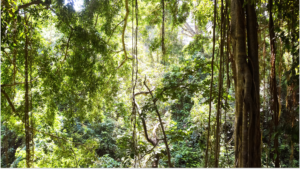17 year-old Elias Malmqvist’s take on social media’s rose-colored glasses on Bali

Nusa Dua Beach - one of the most beautiful beaches in Bali.
November 14, 2024
Online vs reality: Bali without the lens of social media
Bali, the world-famous Indonesian island I have been lucky enough to call home for the past four years, is often referred to as the “Island of the Gods.”
A beautiful, cheap, summer paradise: this is a common conception of Bali among my friends from across the world. In fact, it’s almost the only thing people think of. There are more than 70 million posts on Instagram with the hashtag #bali, so there is no shortage of content that portrays Bali in this way. This is perhaps why millions of tourists visit the island each year.
But how much of it is really true and how much is a shiny facade drawing in vacationers or a dark cloud pushing them away? Here are some of the most common misconceptions that tourists have about Bali.
‘Beaches are the only attraction’
Yes, there is an abundance of beautiful beaches on Bali, but that is not where the attractions end. Social media, with its numerous videos and pictures showing idyllic beaches and turquoise water, does a very good job emphasising this misinterpretation.
I will not minimise the beaches; they are absolutely stunning and amazingly peaceful. That is, if you know where to go. The most popular beaches, such as Nusa Dua, Kuta, Sanur, and Seminyak, are usually packed with vacationers and islanders. But you can find empty and pristine beaches, including Balangan, Virgin, and Padang Padang.
These beaches are not just sand and ocean. They are a place for friends and families to gather and cool down in the refreshing water, catch a surf lesson, or watch the sunset. At all beaches you can find freshly made local food, such as sate (grilled meat on skewers), fish grilled to perfection and fruit juices made right in front of you. And at the popular beaches, they offer jet skis, snorkelling, and other fun aquatic activities.
However, these beaches are not the limits of Bali. The island is filled with endless entertainment in many forms, suitable for everyone.
There are many cultural activities, such as wood carving, jewellery making, and traditional mask making. Tourists can take part in many activities, but note that most of the temples are sacred and not always open to tourists. You must have the proper attire and adhere to the rules and timings provided.
For those of you looking for a little more thrill, Bali offers an extensive waterpark, ATV tours through the jungles of Ubud, and river rafting.
‘Bali is small’
Size is subjective, but social media often depicts Bali as a ‘walking city.’ This may be true if you stick to the central touristy areas—but if you’re a true adventurer, you will find that Bali has other hidden, more exciting gems beyond the roads less travelled.
Geographically, yes, it is a small island: about 153 km wide and 112 km long. Before Bali, I lived in the United States, both in California and North Carolina, and I do miss the feel of a large city and skyscrapers. However, as a resident, I can also say that the island is not as small as people think.
This misconception is due to the fact that many vacationers to Bali visit the three or four main tourist spots, such as Canngu, Ubud, or Kuta. These places are mostly in the central and southern part of the island.
Most tourists completely ignore the west and north. The far west and east are home to many beautiful locations, such as Menjangan, while the northern side features some of the best diving and snorkelling spots like Amed and Lovina. Since these areas have remained untouched by most tourists, they have kept their local flavour.
‘Scooters are not safe’
Many people think Bali is unsafe to drive around, especially on the scooters that many tourists hire. Some of the most popular videos online show the infamous roads of the island as well as small-scale crashes. After driving a motorbike myself for a couple years now, I can say that this mindset is not entirely wrong.
According to Bali Police Chief Inspector General Ida Bagus Kade Putra Narendra, there were more than 7,000 accidents and 632 deaths last year. However, these numbers do not come close to the rate of accidents that happen on a daily basis. Most accidents are not reported because if it is a small fall or slight bump, then most people will get back up, or apologise and go about their day.
Nonetheless, the issue has been blown out of proportion. Most of the videos show foreigners who are out of control, do not know how to drive, or have a lack of care for safety and choose to drive obnoxiously.
If you drive a scooter in Bali, practising before going out on the roads and driving in a composed and calm manner means there is a small chance of anything bad happening. It is up to the driver to ensure that they go through the streets of Bali in a way that is respectful of human life and property.
Overall, Bali has its positives and negatives, like every place on this planet, but it is truly an incredible island. Although social media does a great job of raising awareness that awareness can also limit a traveller’s experiences or perpetuate negative stereotypes.
If Bali is in your realm of possibility, I urge you to experience this unique island and break down these myths and misconceptions for yourself. Everyone will experience the island differently based on where they stay, when they come, and how they act, but the spirit and diversity of Bali is undeniable.
We need all tourists to be respectful and mindful of the locals and their lives, as we are merely visitors to this amazing island. But if you are still debating whether to come to Bali, all I can say is—the real thing is always better than what’s on social media.






